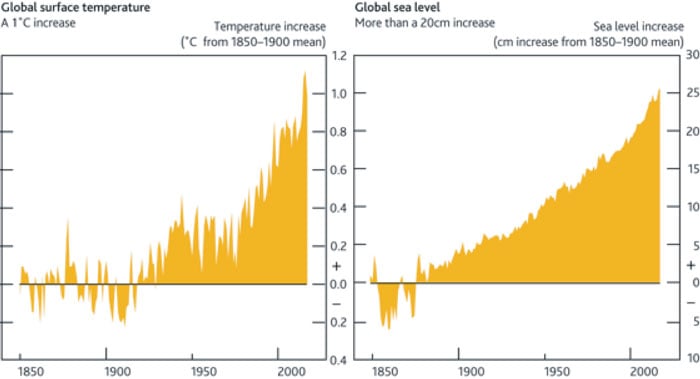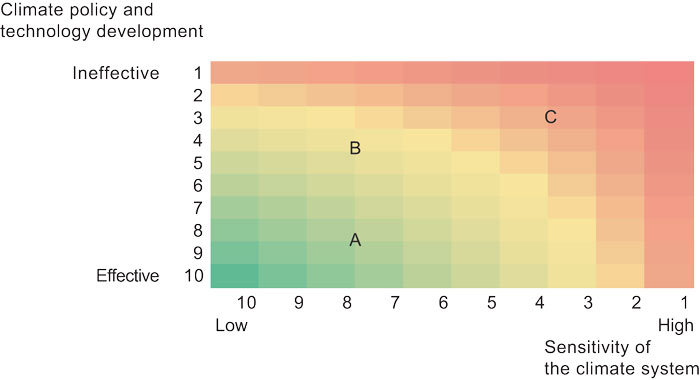2 The climate challenge we are facing
Anthropogenic greenhouse gas emissions are causing climate change. Population growth and economic development based on fossil energy give rise to greenhouse gas emissions, as the result of burning fossil fuels, industrial processes, agriculture and deforestation. Persistently higher greenhouse gas concentrations in the atmosphere are changing the global climate, and the global mean temperature has thus far increased by approximately 1°C since pre-industrial times. A higher average temperature, altered precipitation patterns, more extreme weather, more acidic oceans and sea level rise are already being observed (see Figure 2.1). If emissions continue, the temperature increase will be more pronounced, and the probability of very severe climate change will increase.

Figure 2.1 Global temperature development and sea level increase
Source Bank of England.
It is impossible to survey all potential impacts of climate change. No existing model can fully describe the workings of the entire physical world and how all physical, chemical, geological and biological processes influence each other. Current societies and ecosystems have taken many millennia to adapt to the world in which they exist, and it is impossible to predict how people and societies will respond when faced with rapid and large changes in their surroundings. Impacts of climate changes will depend on how rapidly they occur, how large the changes are, as well as the adaptability of societies and ecosystems.
Climate change may have serious implications for life on Earth. Climate change is causing major alterations in the basis of existence for marine and terrestrial ecosystems. Climate change will have different impacts on different areas. Some areas are likely to experience a combination of significantly reduced precipitation levels and severe regional warming, while other areas will experience a general increase in precipitation and extreme precipitation events. The frequency and intensity of extreme weather and climate events is likely to increase.

Figure 2.2 Illustration of future climate changes
The figure illustrates how future climate changes depend both on climate policy/technology development, in other words how swiftly the world is able to reduce greenhouse gas emissions, and on how the climate system responds to changes in accumulated greenhouse gas emissions. Green corresponds to minor changes and red to dramatic climate changes. The three future scenarios A, B and C, described in chapter 4, are indicated for purposes of illustration.
Source Climate Risk Commission.
Catastrophic climate change cannot be excluded. If critical tipping points are crossed, it may trigger self-reinforcing processes that entail major changes. For example, instabilities in the icecaps in Greenland and Antarctica could result in a multi-metre rise in sea level over hundreds to thousand of years if critical thresholds are crossed. The IPCC special report on 1.5°C warming indicates that some tipping points may be crossed between 1.5 and 2°C warming.
The climate in Norway will become warmer, wetter and wilder. The climate in Norway has changed significantly over the last century and will continue to change, as in the rest of the world. The Norwegian climate is expected to become warmer and wetter, and torrential rain episodes may become more intense and frequent. This may result in altered flooding patterns, changed snow patterns and shrinking glaciers. The oceans are likely to become warmer and more acidic. Rising sea levels will worsen the impact of storm surges. Climate change in the Arctic will also affect weather systems in our latitudes. Continued melting of Arctic sea ice could affect the polar jet stream that largely determines the weather patterns over Norway.
In order to stabilise the temperature increase at a given level, net global greenhouse gas emissions will have to be reduced to zero. Total greenhouse gas emissions over time are the predominant factor in determining the severity of global warming. In order for temperatures to be stabilised, greenhouse gas emissions will have to either cease or be compensated for by greenhouse gases being removed from the atmosphere and stored safely and permanently.
The measures announced until now fall far short of what would be required to reach the target under the Paris Agreement. All countries in the world have through the Paris Agreement agreed to keep global average temperature well below 2°C above pre-industrial levels, and to seek to limit the temperature increase to 1.5°C. However, there is uncertainty associated both with what climate policy will be implemented and with what effect the climate mitigation measures will have. The emission reductions that countries have committed themselves to thus far are not sufficient for reaching the target under the Paris Agreement. If countries only implement the emission reductions reported until now, emissions in 2030 will be on an emission pathway consistent with approximately 3°C warming in 2100. It is uncertain whether it will be possible to stabilise the temperature increase at that level, or whether such warming will trigger self-reinforcing mechanisms in the climate system which will result in further temperature increase – and thus dramatic implications for life on Earth associated therewith.
A fundamental decarbonisation of the global economy is required to reach the Paris targets, and this will also have implications for the Norwegian economy. Climate policy seeks to change stakeholder behaviour through, inter alia, carbon pricing, regulation and stimulation of technological development. Climate-related policy has already contributed to a surge in the development of solar, wind and battery technology. The technological development we are currently witnessing may, in combination with strict climate policy, bring about major and rapid changes in the global energy markets. Such a restructuring is likely to entail a swift and steep reduction in global fossil energy use and a rapid development of low carbon technologies. Both reduced fossil energy demand and technological developments will impact on the Norwegian economy in various ways.
Considerable uncertainty at many levels means significant climate risk. Future social developments, climate policy developments and technology developments are subject to high uncertainty, and these factors have a major impact on greenhouse gas emissions. Furthermore, there is uncertainty with regard to how sensitive the climate system is to changes in greenhouse gas emissions, and uncertainty with regard to the effects of a given level of warming. Dramatic outcomes cannot be excluded, even if the international community were to succeed in limiting emissions in line with the emission pathways we currently believe are sufficient to reach the Paris target. This implies significant climate risk – which needs to be managed.